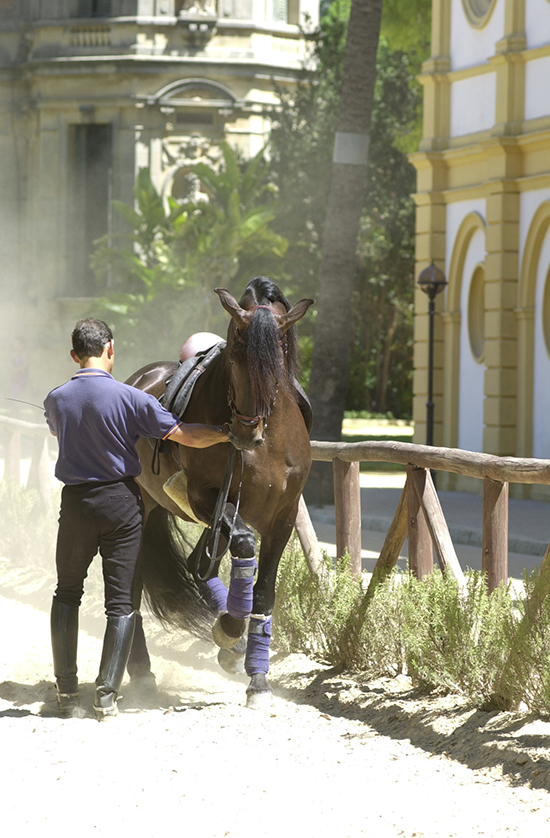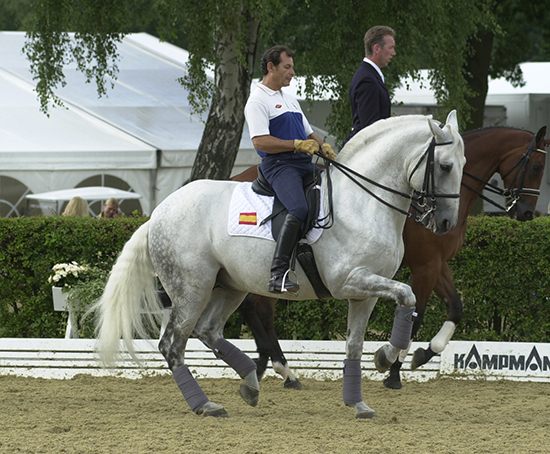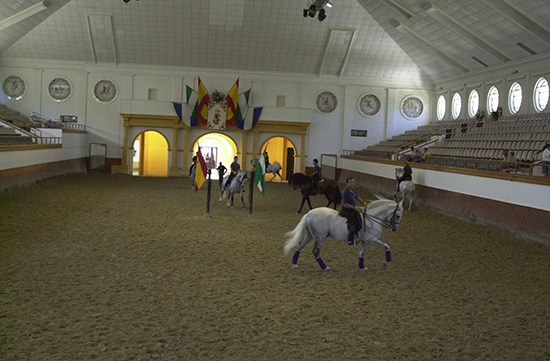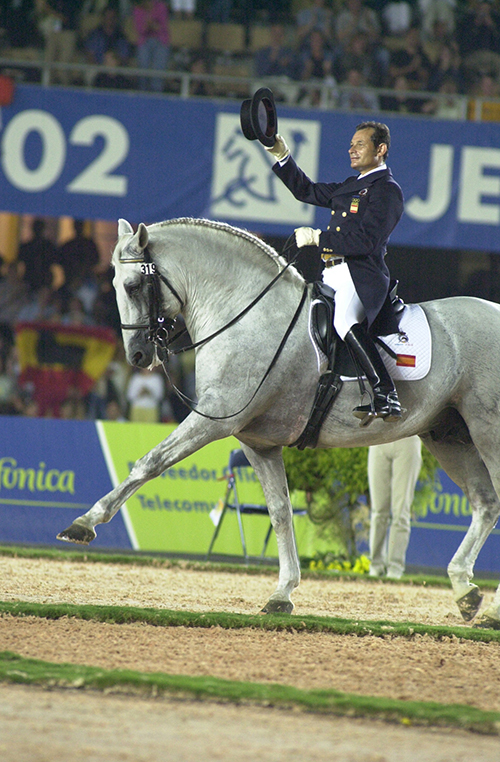Rafael Soto is a fascinating guy. One of the stars of the Royal School of Andalusian Equestrian Art in Jerez, he is also a top competitive rider on the international dressage stage, and will be a key member in the Spanish Dressage Team at the World Championships in his home town later this year. The training at the Royal School is very interesting, for while it draws on the older Spanish tradition, the riders at the School also use modern dressage techniques to produce horses that are internationally competitive. In this interview, Rafael talks about the older tradition of working in hand:
“The most indispensable principle of work in hand, is control of the balance of the horse and his relationship with the ground, this will permit you to develop the collected airs, piaffe and passage, especially piaffe.”
“Our School is a classic school like Vienna and we have a very old tradition of working in hand. We mostly ride the horses for a year and a half until they are five years old, and then start them in hand but it varies with the horse. Some horses, we do some work in hand before we start to ride them. It depends on the temperament. If you have a cold horse, then it is better to work in hand, before riding him. If you have a warm, very excitable horse, then you better work in hand after riding him.”
“The trainer has the rein from the bridle or the cavesson in the left hand and the whip in the right, when you are working him to the left, and the opposite when you are working to the right. It is very important to work the horse on both reins, otherwise the horse can get used to being only in one hand, then he will not work with the same symmetry with both hind legs.”
When you work with the cavesson is that with side reins?
“Sometimes yes, sometimes no. If the horse is too strong in the mouth, you put the side reins on to have him more collected.
When the horse starts to understand the principle of the piaffe, he can move diagonally in trot, nearly on the same spot – always a little bit forward. People think in piaffe it is very important that the horse stays on the spot – no, no, no, no! It is not important that the horse stay on the spot. The horse must always want to go forward, forward, forward. If you try to stop the horse going forward in the beginning in the piaffe, he starts to go from side to side with his hind legs or with his front legs, or he has the hind legs too far behind. Many times it happens because the rider forces the horse to stay on the spot in piaffe, too soon. The horse is only able to stay on the spot, ONLY when the horse has the development of years of training in a good system of training.”
“After years and years you can sometimes stay on the spot. Especially if you are doing a Grand Prix, you must try to stay in the spot the most you can. But you have seen many good riders and good horses at the Olympic Games or the World Equestrian Games, at the European Championships, even the gold medal winner Rusty is not able to stay in the spot 100%, he goes a little bit forward, but Ulla Salzgeber prefers to go a little bit forward in piaffe, than try to stop the horse and so will make mistakes. Very few horses are able to be in the spot 100%.”
“The horse in the work in hand in piaffe always has to go a little bit forward to give the regularity to the movement. The hand holding the rein is probably more important in the work in hand than the hand that has the whip. The hand that has the reins, or the cavesson, this hand makes the half halts necessary to control the balance, to make sure the horse doesn’t go too far forward, or too much on the hand, or he is too much behind the hand. With some horses it is more necessary to put their neck down in the piaffe if he doesn’t give the back enough – and some other horses you must bring up so the shoulder can be more free. It depends on how the back of the horse is made.”
“Another very important principle of the training system of work in hand is timing, especially for the piaffe. The piaffe is the basis of the work in hand – after the piaffe will come the passage. You cannot force the horse, you just use the whip and the half halt with the other hand to bring him into balance and to give him activity, and then at the beginning you are happy with five or six steps of what is not really piaffe, but it starts to be. Then finish!”
“The people who force the horse to do too much piaffe – even if the horse is Andalusian and therefore has more natural ability for the piaffe – they will make the horse too tired, he will block the brain, the horse will give up, he will not find the rhythm and then he will always be scared of this work because the trainer has forced him too much into too many steps of piaffe.”
“It is very important to do very very little piaffe. Short time, then pat the horse – then piaffe again, walk again. The walk in between is very important, it has to be a good walk, collected walk. Then when the horse is worked this way, he will do piaffe. You don’t do anything, you just move the horse to a collection, and you just talk to him, click click click, a little whip, and he himself, he knows it. You pat him, immediately. The horse knows that he has done a good thing. And then don’t ask again too much.”
“If you give more and more pressure and the horse gets afraid and excited, and you don’t give the pause or the break to let the horse understand what you are asking of him, then you will do wrong. Maybe you are trying to do something right but it will be wrong – better not to do it. Some of the jumping riders say piaffe is ‘scaring on the spot’ and it is true for riders who don’t know how to do it, they only teach scaring on the spot, not piaffe.”
“When the horse knows the piaffe in hand, then you can do it on his back, you use your legs, the same collection of the walk. Always in the beginning from walk to piaffe – when the horse knows from walk to piaffe on the ground, then you can do it from his back. Then when he knows the technique a little bit better, you can do it from trot to piaffe – trot to piaffe, trot to piaffe, then when you have the piaffe, from piaffe to passage.”
It is interesting in Germany for instance, there are some famous people who work on the ground, but many riders who buy these horses say that when there is no one on the ground, the horse will not do piaffe…
“This is a question of the way of training. Normally we touch with the whip sometimes – if you touch every step, then the horse gets used to the whip. The horse has to know how you build the piaffe – whip, half halt in the hand, and the voice. The moment the horse knows that then you don’t use the whip to activate him for the piaffe, take the whip away, and just with a little bit the voice and the collection of your hand on the mouth of the horse, and the horse has to do it himself. Because if you use the whip every step, then the horse gets used to the whip, and the whip is not there, or the man is not there, it doesn’t happen. It has to be done this way – you touch with the whip sometimes, then let the horse do it – he has to do it just on the voice, in rhythm with the voice, click, click, click. The moment he goes down in the rhythm, then touch again, then try again with no touch.”
“The horse has to do it himself. It is the same in riding, if the rider is push and push and push, the horse loses the sensitivity, then he doesn’t really move. The good riders know when to use their legs and when not. The real good riders, they use the leg at the moment, then the moment later there is no legs, just balance. The horse himself must do it, then you have a sensitive horse – a horse that goes automatically into the piaffe, when the rider thinks that the horse should go into piaffe. This is the basic of the piaffe.”
Do you have a problem that your Spanish horses naturally want to passage, then when they passage, they lose the normal trot?
“No, no, no, no, no…. For our horses, especially the Andalusian horses, the piaffe and the passage help our horses to have a better trot. Our horses always have a little bit of a problem to find a balanced, up in the air trot with swing in the collected trot. The piaffe and the passage builds up the muscles of the back to let the horse trot with more swing, more in the air. Our horses are not so strong like the Warmbloods, when our horses are three or four, then the trot is normally a very flat trot, and only with the piaffe and passage will this trot come more really into a working trot and collected trot. From the piaffe / passage and the half halt, come back to piaffe a few steps and go forward in trot, and again back to piaffe, then again forward in trot, then the horse has better muscles in the back, a better position in the back, to make swing in the trot that we need for the half passes and the travers.”
In the Royal School you use the pillars….
“Yes but we don’t ever train a horse to do piaffe in the pillars. We only use the pillars, because this was an old tradition of training piaffe, but you cannot put every horse there – only the horse that already knows the work. We never ever train the horse in the pillars for piaffe. When we put a horse in the pillars, he knows already the piaffe very very well. Then we show for the people the piaffe in the pillars. If you take 100 horses and put them n the pillars – 80 or 90 of them will never learn piaffe, they will get too excited and go from side to side because they cannot go forward. To have a horse piaffe on the spot, you must have a horse that is already trained and already knows very very good piaffe. The horse we show in the pillars in our performance, is one of the horses with the better piaffe in the work in the hand – this is the horse we use for the pillars. We develop the piaffe on the ground, in hand. Sometimes if it is a difficult horse, with two riders, one in front, one behind – when it is an easier horse, just one rider on the ground, in front, one hand on the mouth of the horse, one hand with the whip.”
“I have seen a few, very few horses, that could be put in the pillars and then very very gently train piaffe – it can be done but it is not the best system because most horses will learn a wrong piaffe, swinging to the sides with the front legs, or the hind legs, because they are not able to walk forward. They need to walk forward. When the horse is a fantastic horse, and he is nine or ten years old, then he is able to be in the spot, not from the beginning.”
If you go to a big competition, like the Olympics, do you work your horse in hand there?
“Normally not, because the horses we have taken to the Olympic Games, are very experienced horses. Sometimes maybe…. I remember at the Olympic Games of Atlanta, my horse Invasor was very young, he was only seven years old, and sometimes Ignacio (Ramblas, director of the Royal School) helped me a little bit from the ground but very little. Normally our horses that go to top competitions are very well trained, and don’t need it.”
And the brown horse you worked today?
“With this young horse, I trained in the piaffe before riding, and the same with Invasor, I trained him on the ground when he was younger but not after riding – I didn’t need it. If you have trained in a good way, and the horse does piaffe, then you don’t have to go back. Okay, you can do it, if you have a problem in a certain moment with the horse in the piaffe, then go down to basics, go to the ground again. But we always use the work in the ground for piaffe, in the beginning when the horse is 5, 6, 7 years, for the piaffe and for the passage.”
“In my opinion, only very very good riders are able to do work in hand. There are many good riders who don’t know how to do work in hand, but only a good rider can do good work in hand. If you are not a very good rider it is very difficult to understand the sensibilities and balance on the half halts, when to use the whip, when to use the voice – it is very difficult to have these sensibilities if you are not a very good rider. An ordinary rider – I don’t think he will be able to do good work in hand. Only a very good rider is able to do work in hand very well.”




